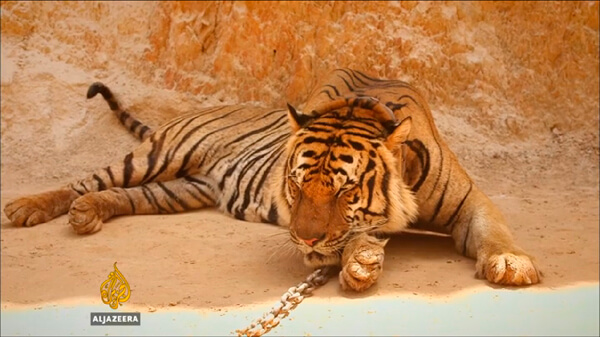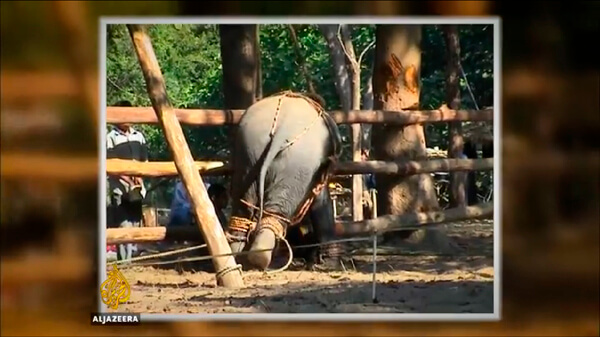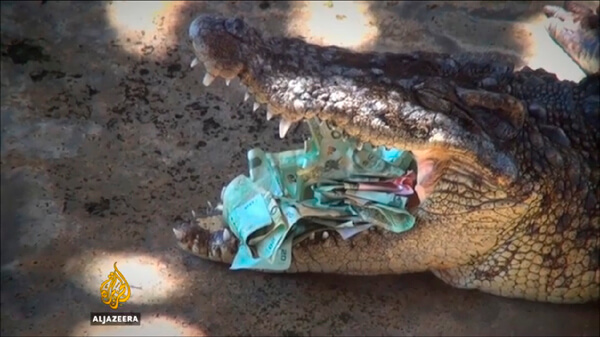This post won’t have any beautiful photos of Asia, as I’ve chosen not to promote these activities. Please read it if you plan a trip to the area. I think it’s important information.
One of the first articles I came across when I began researching my upcoming trip to Thailand was about Tiger Temple. A temple where tigers roam freely? Could it really be true? It is run by monks, how could the animals not be treated well? After all, Buddhists believe animals should be treated kindly and with respect. The doctrine of karma instructs us that wrong actions will have to be paid for in future lives. Surely the monks are not mistreating these majestic beasts.
Something wasn’t sitting right with me on this one, so I did some exploring. That queasy feeling I had in my stomach was bang on. Some of the following I knew, some of it I’ve become more educated on, but all of it I can’t support, no matter how badly I would love to cuddle a big cat or ride an elephant through the jungle.
So here goes, my list of three things I won’t be doing on my upcoming trip to Southeast Asia.
Tiger Temple
As the story goes, Tiger Temple, or Wat Pa Luang Ta Bua, in Kanchanaburi, Thailand, got its start years ago when an orphaned tiger cub, its mom killed by poachers, was brought to the abbot. He cared for her and word spread, so more tigers were delivered to the temple. That, combined with irresponsible breeding, grew the population to almost 150 tigers today. As word spread about the tigers at the temple, the tourists came. Even Time magazine wrote about it in an article featuring “The Best of Asia” in 2006.
Today, thousands of tourists flock to the temple, happily paying a steep price to get a photo with a tiger or to bottle feed a baby. Despite temples not being allowed to charge entrance and photography fees, people cough up both– about $15 for entry and anywhere from 1000 baht ($28 US) to touch them, to 5000 baht ($138 US) for the prized photo.
“A tiger penis goes for a lot in China”
So what’s the problem here? Well, firstly, the tigers are often chained up. Some look thin and from the panting going on, looked overheated or dehydrated. The most damning evidence of mistreatment, though, comes from those that have worked there. There are reports of no exercise, poor health care, and taking babies from their mothers at only a few weeks old so tourists can bottle feed them (overfeeding them to the point of regurgitation). Well over a hundred tigers in a too-small pen causes territory issues, fights, and ultimately, injury. And most disturbingly, there are missing adult cats, presumably sold on the black market. A tiger penis goes for a lot in China.

From the film “Saving Thailand’s Animals” by Drew Ambrose
After years of complaints from animals’ rights groups, the government finally stepped in in February of this year. They raided Tiger Temple on the grounds of wildlife trafficking. Authorities also charged that the temple had been keeping animals without paperwork and, in April, vowed to seize the 146 big cats. The temple was also banned from charging tourists any fees and putting the animals on display. Sadly, when it came time to seize the tigers, officials instead decided to register the animals and scanned their microchips. They’ve claimed the tigers and any offspring as state assets, and it’s back to business as usual at Tiger Temple.
Also worth considering, on the flip side of the tigers’ mistreatment is the danger they pose for the monks and tourists. In May of this year, the abbot was admitted to intensive care due to injuries caused by an eight-year resident. There have been several reports in the news about tigers injuring tourists as well.

From the film “Saving Thailand’s Animals” by Drew Ambrose
I’m a believer in people, and I like to think when this all started it was not for the purpose of making money. I believe the abbot did care for the baby tiger and had good intentions. I suspect things got distorted somewhere along the way, however, and it has turned into a mess, with the tigers, as well as the resident Asian black bears and hornbills, suffering. If you want to gain a bit of insight, partly from by the former caregiver of the tigers as well as the monks and government officials, watch this short film titled Saving Thailand’s Animals by Drew Ambrose. The Tiger Temple clip starts at about 6:10.
Elephant Riding
The mistreatment of elephants, Thailand’s national animal, is one of the most upsetting animal atrocities I’ve come across. Across Asia, elephants are taken from their mothers by poachers, their mothers often killed in front of them. Elephants are sensitive, familial loving animals. And they are wild, no matter what someone tries to tell you. It is said it takes 10 generations to domesticate an animal. Don’t kid yourself that the elephant that seems happy to be led around by a mahout is happy– it is just broken. In fact, there is a name for it– phajaan– literally, “the crush”. Its purpose is to break the spirit of the animal by torture and utter humiliation. Only then will an animal be capable of being ridden. Despite their size, elephant’s spines are not built to carry weight like a horse. This causes the elephant much pain and problems with things like arthritis in later years.
“We should all, with ultimate respect,
meet the animal on his terms,
and that means going in with the intention of doing no harm.”
Please keep this in mind if you think you might like to ride an elephant on holiday. I urge you to again watch Saving Thailand’s Animals by Drew Ambrose. The story on breaking baby elephants starts at about 18:20. A warning that it’s not pretty, but if you think you want to engage in elephant activities, you owe it to them to sit through it, then you can make an informed decision. Watch it here.

From the film “Saving Thailand’s Animals” by Drew Ambrose
One area of improvement popping up in Thailand are elephant sanctuaries. Sarah Reid has written an excellent article titled How to Interact Ethically with Elephants in Thailand. This is what I plan to do on my trip. Keep an eye out for outfits that claim to be sanctuaries, but keep the elephants chained or use sticks on them. A true sanctuary lets the animals roam freely. Here is another informative article on elephant welfare and your travels.
Kopi Luwak Coffee
I came across this one quite by accident. In doing some research on foods native to Indonesia, I found a story about kopi luwak, the most expensive coffee in the world. I was intrigued. I learned that kopi luwak comes from the feces of Asian palm civets– small, rather fierce-looking mammals. Traditionally, the civets would eat the wild coffee berries, the coffee beans (or seeds) would ferment in their stomachs, but not be digested. 24 hours later, the civet poops out the seeds and farmers would collect their droppings, wash them, and dry them in the sun. Then they are pounded, sorted and roasted.
This intrigued me. Poop coffee. Hmm. A pound of it can go for over $300. The fermentation is said to give it a caramel flavour. For that price, it must be good, right? I was up for it. It seemed less daunting than eating bugs in Thailand. A bit more research and I came across the ugly truth. Of course people are exploiting this.
No longer are the droppings from wild civets used (or maybe they are, but they’re not the norm), but now civets are being kept in cages and fed only a debilitating diet of coffee berries. Civets are naturally omnivores. It is estimated that tens of thousands of civets are being kept in these conditions. It is not only cruel and unusual, but experts think it could potentially lead to an endangerment of the species.
The Choice is Up to You
It’s up to you to come to a decision about engaging in these or any other animal interactions wherever you travel. I have to admit, I hope armed with a bit of knowledge you will choose to land on the side of animal welfare. But don’t just take my word for it. The internet is full of stories. Do your own research, explore. In the end, ask yourself: does it really feel right to swim in a pool of caged dolphins or pay to have your photo taken with a monkey in a bikini at the beach? Think about what’s going on behind the scenes.
And finally, a confession: I, too, once supported one of these atrocities. It was in Canada, my son was young. We were at the African Wildlife Safari park in Ontario. It’s a massive nature game park. There were no chains. I didn’t see a bull hook, but I’ve since been told the trainers carry them. The elephant “seemed” happy. I put my excited young son atop an elephant’s back for a stroll around a pen. I took plenty of photos.
It makes me feel sick that I supported cruelty to that animal, to all the animals, in fact, that may be mistreated there. I won’t go so far as to say that all zoos have no role in conservation and animal education, but certainly any that are putting on shows and forcing animals to perform should be regulated more closely. Those animals had land to roam, they looked well taken care of. It was my mistake in thinking that this meant they had not suffered abuse.
Because of my lack of knowledge and the poor decision I made, I now hope to equip someone else before they embark on something they may later wish they hadn’t. Of course we all want to interact with animals, to engage with them, to share a special moment with them. They are infinitely beautiful. But we can’t be selfish about it. It can’t be on our terms. We should all, with ultimate respect, meet the animal on his terms, and that means going in with the intention of doing no harm.





It’s a shame you don’t have got a donate button! I’d certainly donate for this excellent blog! I suppose for the time being i’ll be satisfied with bookmarking and adding your RSS feed to my Google account.
I anticipate new updates and will share this website with my Facebook group.
Chat soon!
Today, I went to the beach with my children. I found a sea shell and gave it to my 4 year old daughter and said “You can hear the ocean if you put this to your ear.” She placed the shell to her ear and screamed. There was a hermit crab inside and it pinched her ear. She never wants to go back! LoL
A very sobering post. I’ve come across all sorts of similar touristy activities – the caves where birds nests come from to make soup in Thailand, pictures with iguanas and swimming with Dolphins in Mexico… Any time there is a feeling of discomfort, even without actual evidence of mistreatment, that feeling should not be ignored. Thank you for looking into this.
Leah Price recently posted…Global Climate March – A Waste Audit of Sorts
Thanks, Leah. You’re absolutely right about that gut feeling. And with information available today at our fingertips, there’s no need to go in uneducated.